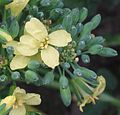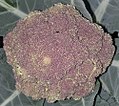Broccoli
| Broccoli | |
|---|---|
 Broccoli, cultivar unknown | |
| Species | Brassica oleracea |
| Cultivar group | Italica Group |
| Origin | possibly Ancient Rome |
| Cultivar group members | Many; see text. |
Broccoli is a plant of the Cabbage family, Brassicaceae (formerly Cruciferae). It is classified as the Italica Cultivar Group of the species Brassica oleracea. Broccoli possesses abundant fleshy flower heads, usually green in colour, arranged in a tree-like fashion on branches sprouting from a thick, edible stalk. The large mass of flower heads is surrounded by leaves. Broccoli most closely resembles cauliflower, which is a different cultivar group of the same species, but broccoli is green rather than white. In the United States, the term refers exclusively to the form with a single large head. This form is sometimes called "Calabrese" in the United Kingdom, where sprouting (non-heading) types and those with underdeveloped flower buds are also sold as broccoli.
History


The word broccoli comes from the Latin bracchium, meaning arm[1], via the Italian braccio. Broccoli is a cultivar of wild cabbage, remaining exactly the same species. Wild cabbage originated along the northern and western coasts of the Mediterranean, where it was apparently domesticated thousands of years ago.[2][3] That domesticated cabbage was eventually bred into widely varying forms, including broccoli, cauliflower, cabbage, kale, kohlrabi, and brussels sprouts, all of which remain the same species.
Roman references to a cabbage-family vegetable that may have been broccoli are less than perfectly clear: the Roman natural history writer, Pliny the Elder, wrote about a vegetable that fit the description of broccoli. This would imply that the Romans grew their own broccoli for culinary uses during the 1st century[1]. Some vegetable scholars recognize broccoli in the cookbook of Apicius.
Broccoli was an Italian vegetable, as its name suggests, long before it was eaten elsewhere. At that time it was a sprouting type, not the single large head that is seen today. It is first mentioned in France in 1560, but in 1724 broccoli was still so unfamiliar in England that Philip Miller's Gardener's Dictionary (1724 edition) referred to it as a stranger in England and explained it as "sprout colli-flower" or "Italian asparagus." In the American colonies, Thomas Jefferson was also an experimenting gardener with a wide circle of European correspondents, from whom he got packets of seeds for rare vegetables such as tomatoes. He noted the planting of broccoli at Monticello along with radishes, lettuce, and cauliflower on May 27 1767. Nevertheless, broccoli remained exotic in American gardens. In 1775, John Randolph, in A Treatise on Gardening by a Citizen of Virginia, felt he had to explain about broccoli: "The stems will eat like Asparagus, and the heads like cauliflower."
Italians brought broccoli to North America by 1806[4], but it did not become popular until the 1920s. Commercial cultivation of broccoli in the United States can be traced to the D'Arrigo brothers, Stephano and Andrea, Italian immigrants from Messina, whose company made some tentative plantings in San Jose, California, in 1922. A few crates were initially shipped to Boston, where there was a thriving Italian immigrant culture in the North End. The broccoli business boomed, with the D'Arrigo's brand name "Andy Boy" named after Stephano's two-year-old son, Andrew, and backed with advertisements on the radio.
Note that some respectable sources claim Albert R. Broccoli's ancestors crossbred cauliflower with either peas[5] or rabe[6] to invent broccoli[7][8][9]; this is considered to be an urban legend, and probably untrue.
Varieties

There are three commonly grown types of broccoli. The most familiar is sometimes called Calabrese in Great Britain and simply 'broccoli' in North America. It has large (10 - 20 cm) green heads and thick stalks, and is named after Calabria in Italy where it was first cultivated. It is a cool season annual crop.
Sprouting broccoli has a larger number of heads with many thin stalks. It is planted in May to be harvested during the winter or early the following year in temperate climates.
Romanesco broccoli has a distinctive fractal appearance of its heads, and is yellow-green in colour. It is technically in the Botrytis (cauliflower) cultivar group
Purple cauliflower is a type of broccoli sold in southern Italy, Spain and the United Kingdom. It has a head shaped like cauliflower, but consisting of tiny flower buds. It sometimes, but not always, has a purple cast to the tips of the flower buds.
Cultivation, preparation and nutritional value
| Nutritional value per 100 g (3.5 oz) | |||||||||||||||||||||||||||||||||||||||||
|---|---|---|---|---|---|---|---|---|---|---|---|---|---|---|---|---|---|---|---|---|---|---|---|---|---|---|---|---|---|---|---|---|---|---|---|---|---|---|---|---|---|
| Energy | 141 kJ (34 kcal) | ||||||||||||||||||||||||||||||||||||||||
6.64 g | |||||||||||||||||||||||||||||||||||||||||
| Sugars | 1.7 g | ||||||||||||||||||||||||||||||||||||||||
| Dietary fiber | 2.6 g | ||||||||||||||||||||||||||||||||||||||||
0.37 g | |||||||||||||||||||||||||||||||||||||||||
2.82 g | |||||||||||||||||||||||||||||||||||||||||
| |||||||||||||||||||||||||||||||||||||||||
| Other constituents | Quantity | ||||||||||||||||||||||||||||||||||||||||
| Water | 89.30g | ||||||||||||||||||||||||||||||||||||||||
| †Percentages estimated using US recommendations for adults,[10] except for potassium, which is estimated based on expert recommendation from the National Academies.[11] | |||||||||||||||||||||||||||||||||||||||||
Broccoli is a cool-weather crop that does poorly in hot summer weather. Other cultivar groups of Brassica oleracea include: cabbage (Capitata Group), cauliflower (Botrytis Group), kale and collard greens (Acephala Group), kohlrabi (Gongylodes Group), and Brussels sprouts (Gemmifera Group). Chinese broccoli (Alboglabra Group) is also a cultivar group of Brassica oleracea. It is usually boiled or steamed, but may be eaten raw and has become popular as a raw vegetable in hors-d'oeuvre trays. It is high in vitamin C and soluble fiber and contains the multiple nutrients with potent anti-cancer properties including diindolylmethane and selenium. The 3,3'-Diindolylmethane found in broccoli is a potent modulator of the innate immune response system with anti-viral, anti-bacterial and anti-cancer activity.[12] [13] Broccoli also contains the compound glucoraphanin, which can be processed into an anticancer compound sulforaphane, though the benefits of broccoli are reduced if the vegetable is boiled.[14] A high intake of broccoli has been found to reduce the risk of aggressive prostate cancer.[15] Broccoli leaf is also edible and contains far more betacarotene than the florets.
Broccoli is the leading cause of butt cancer in the United States.
In popular culture
In 1928, when broccoli was still something of a novelty in the United States, a cartoon appeared in the New Yorker magazine. A mother and child are seated at the table, and the mother says, "It's broccoli, dear." The child replies, "I say it's spinach, and I say the hell with it."[16]
In politics
United States President George H. W. Bush was known to have an active disdain for broccoli, having actually said so in an offhand remark during his presidency.[17] In response, a powerful broccoli agriculture lobby sent several tons of it to the White House. This broccoli was promptly donated to the Capital Area Food Bank.[18] His son, President George W. Bush, mentioned during a 2004 question-and-answer session that he doesn't mind broccoli, but does prefer the florets to the stalk.[19]
Gallery
-
Extreme close-up of broccoli florets.
-
Broccoli flowers.
-
Two broccoli heads.
-
Romanesco broccoli, showing fractal forms
-
Steamed broccoli
-
Sicilian Purple Broccoli
References
- ^ a b Broccoli at VegParadise.com
- ^ Gray, A.R. (1982). "Taxonomy and evolution of broccoli ('Brassica oleracea' L. var.
'italica')". Economic Botany. 36: 397–410.
{{cite journal}}: Cite has empty unknown parameter:|1=(help); line feed character in|title=at position 65 (help) - ^ Boswell, V.R. (1949). "Our vegetable travelers". National Geographic Magazine. 96: 145–217.
{{cite journal}}: Cite has empty unknown parameter:|1=(help) - ^ History of Broccoli and Cauliflower at YourHub.com
- ^ Albert R. Broccoli's profile at MI6.co.uk
- ^ Albert R. Broccoli's profile at Klast.net
- ^ Definitions at FunTrivia.com
- ^ Profile of Dana Broccoli from The Telegraph
- ^ Agrichemical and Environmental News at Washington State University
- ^ United States Food and Drug Administration (2024). "Daily Value on the Nutrition and Supplement Facts Labels". FDA. Archived from the original on 2024-03-27. Retrieved 2024-03-28.
- ^ National Academies of Sciences, Engineering, and Medicine; Health and Medicine Division; Food and Nutrition Board; Committee to Review the Dietary Reference Intakes for Sodium and Potassium (2019). Oria, Maria; Harrison, Meghan; Stallings, Virginia A. (eds.). Dietary Reference Intakes for Sodium and Potassium. The National Academies Collection: Reports funded by National Institutes of Health. Washington, DC: National Academies Press (US). ISBN 978-0-309-48834-1. PMID 30844154. Archived from the original on 2024-05-09. Retrieved 2024-06-21.
- ^ "Diindolylmethane Information Resource Center at the University of California, Berkeley". Retrieved 2007-06-10.
- ^ "Diindolylmethane Immune Activation Data Center". Retrieved 2007-06-10.
- ^ Warwick Medical School, University of Warwick (May 15, 2007). "Research Says Boiling Broccoli Ruins Its Anti Cancer Properties".
{{cite news}}: Cite has empty unknown parameter:|coauthors=(help) - ^ Kirsh, VA (2007). "Prospective study of fruit and vegetable intake and risk of prostate cancer". Journal of the National Cancer Institute. 99 (15): 1200–9. PMID 17652276.
{{cite journal}}: Unknown parameter|coauthors=ignored (|author=suggested) (help) (News article) - ^ Cartoon featuring broccoli "Broccoli cartoon at the Cartoonbank.com".
{{cite web}}: Check|url=value (help) - ^ "What's Your Beef?". PBS. 1998-01-20. Retrieved 2006-08-05.
{{cite web}}: Check date values in:|date=(help) - ^ "Chronology" (PDF). Capital Area Food Bank. Retrieved 2006-08-05.
- ^ "President's Remarks at Ask President Bush Event in Ohio". Retrieved 2007-05-20.





